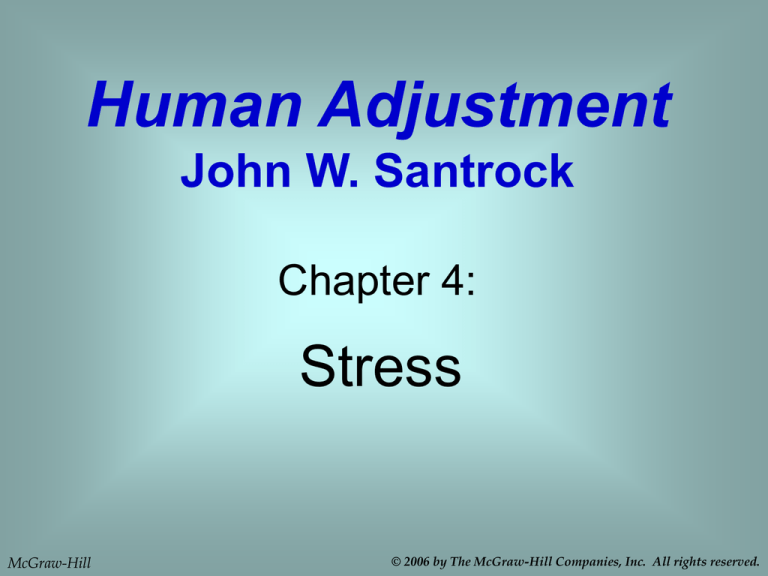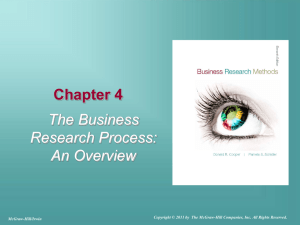
Human Adjustment
John W. Santrock
Chapter 4:
Stress
McGraw-Hill
© 2006 by The McGraw-Hill Companies, Inc. All rights reserved.
4-2
Outline - Chapter 4
What is Stress?
Stress and Illness
Sources and Mediators of Stress
Post-Traumatic Stress Disorder
McGraw-Hill
©2006 by the McGraw-Hill Companies, Inc. All rights reserved.
4-3
Learning Goals - Chapter 4
1. Explain what stress is and describe its major
components
2. Discuss the links between stress and illness
3. Identify key sources and buffers of stress
4. Characterize post-traumatic stress disorder
McGraw-Hill
©2006 by the McGraw-Hill Companies, Inc. All rights reserved.
4-4
WHAT IS STRESS?
Definition of Stress
General Adaptation Syndrome
Cognitive Appraisal
McGraw-Hill
©2006 by the McGraw-Hill Companies, Inc. All rights reserved.
4-5
Definition of Stress
Stress = response of
individuals to stressors
Stressors = circumstances and events that threaten
individuals and tax their coping abilities
McGraw-Hill
©2006 by the McGraw-Hill Companies, Inc. All rights reserved.
4-6
General Adaptation Syndrome
General Adaptation Syndrome (GAS) - Selye’s term
for common effects on body when stressors persist
GAS consists of:
– alarm
– resistance
– exhaustion
McGraw-Hill
©2006 by the McGraw-Hill Companies, Inc. All rights reserved.
4-7
General Adaptation Syndrome
Alarm Stage
– Body’s resources are mobilized to prepare organism to deal
with threat
Resistance Stage
– Body adapts to the continued presence of the stressor
Exhaustion Stage
– If the threat and the body’s response continues, possible
irreversible damage to the body, or even death, may occur
McGraw-Hill
©2006 by the McGraw-Hill Companies, Inc. All rights reserved.
Figure 4.1 Selye’s General Adaptation
Syndrome
McGraw-Hill
4-8
©2006 by the McGraw-Hill Companies, Inc. All rights reserved.
4-9
Pathways in Body’s Response to Stressors
Two main pathways are involved in the body’s
response to stressors:
– neuroendocrine-immune pathway
– sympathetic nervous system pathway
McGraw-Hill
©2006 by the McGraw-Hill Companies, Inc. All rights reserved.
Figure 4.2 Two Biological
Pathways in Stress
McGraw-Hill
4-10
©2006 by the McGraw-Hill Companies, Inc. All rights reserved.
4-11
Cognitive Appraisal
Cognitive appraisal - Richard Lazarus’ term for
individual’s interpretation of events in their lives, and
their determination of whether they have the resources
to effectively cope with the events
Cognitive appraisal consists of:
– Primary appraisal (Is the stressful event harmful,
threatening, or challenging?)
– Secondary appraisal (What resources do I have to cope
with the stressful event?)
McGraw-Hill
©2006 by the McGraw-Hill Companies, Inc. All rights reserved.
Figure 4.3 Lazarus’ Cognitive Appraisal
View of Stress
McGraw-Hill
4-12
©2006 by the McGraw-Hill Companies, Inc. All rights reserved.
4-13
Review - Learning Goal 1
– What is stress?
– What is the general adaptation syndrome?
– How does cognitive appraisal influence the response to
stress?
McGraw-Hill
©2006 by the McGraw-Hill Companies, Inc. All rights reserved.
4-14
STRESS AND ILLNESS
Stress and the Immune System
Stress and Cardiovascular Disease
Stress and Cancer
McGraw-Hill
©2006 by the McGraw-Hill Companies, Inc. All rights reserved.
4-15
Stress and the Immune System
Psychoneuroimmunology is the field that explores
connections among psychological factors, the nervous
system, and the immune system
– Acute stressors can produce immunological changes in
healthy individuals
– Chronic stressors are associated with a decrease in
immune system functioning
Positive social life and low stress are associated with
increased ability to fight cancer
McGraw-Hill
©2006 by the McGraw-Hill Companies, Inc. All rights reserved.
4-16
Stress and Cardiovascular Disease
Chronic stress is associated with
– high blood pressure
– heart disease
– early death
Emotional stress contributes to cardiovascular disease
McGraw-Hill
©2006 by the McGraw-Hill Companies, Inc. All rights reserved.
4-17
Stress and Cancer
Andersen believes stress and cancer are linked
through their effects on:
– quality of life
– behavioral factors
– biological pathways
McGraw-Hill
©2006 by the McGraw-Hill Companies, Inc. All rights reserved.
4-18
Review - Learning Goal 2
– What is psychoneuroimmunology, and what has it revealed
about the immune system?
– How is stress linked with cardiovascular disease?
– What is the connection between stress and cancer?
McGraw-Hill
©2006 by the McGraw-Hill Companies, Inc. All rights reserved.
4-19
SOURCES AND MEDIATORS OF STRESS
Environmental Factors
Personality Factors
Work-Related Factors
Sociocultural Factors
McGraw-Hill
©2006 by the McGraw-Hill Companies, Inc. All rights reserved.
4-20
Environmental Factors
Environmental factors that can be sources of stress
include:
– significant life events (such as major changes)
– daily hassles (ongoing daily annoyances)
– conflict
– overload
McGraw-Hill
©2006 by the McGraw-Hill Companies, Inc. All rights reserved.
4-21
Life Events and Daily Hassles
People who experience clusters of major life events
(loss of close relative, loss of job) tend to become ill
Daily hassles (ongoing daily annoyances) can also
produce health-sapping stress
McGraw-Hill
©2006 by the McGraw-Hill Companies, Inc. All rights reserved.
4-22
Life Events and Daily Hassles
Hassles for college students include:
– wasting time
– being lonely
– worrying about meeting high
achievement standards
McGraw-Hill
©2006 by the McGraw-Hill Companies, Inc. All rights reserved.
4-23
Life Events and Daily Hassles
Daily uplifts of college students include:
– having fun
– laughing
– going to movies
– getting along well with friends
– completing a task
McGraw-Hill
©2006 by the McGraw-Hill Companies, Inc. All rights reserved.
4-24
Conflict
Three types of conflict are:
– Approach/approach conflict - conflict in which the
individual must choose between two attractive stimuli or
circumstances (least stressful)
– Avoidance/Avoidance conflict - conflict in which the
individual must choose between two unattractive stimuli or
circumstances
– Approach/avoidance conflict - conflict involving a single
stimulus or circumstance that has both positive and
negative characteristics
McGraw-Hill
©2006 by the McGraw-Hill Companies, Inc. All rights reserved.
4-25
Overload
Daily hassles can result in overload, which can lead to
burnout
Burnout = state of physical and
emotional exhaustion that includes
a hopeless feeling, chronic fatigue,
and low energy
McGraw-Hill
©2006 by the McGraw-Hill Companies, Inc. All rights reserved.
Adjustment Strategies
for Avoiding Burnout
4-26
1. Take inventory of what is causing stress
2. Pare down some of your commitments
3. Do things you enjoy
4. Recognize when to seek outside help
McGraw-Hill
©2006 by the McGraw-Hill Companies, Inc. All rights reserved.
4-27
Personality Factors - Type A / Type B
Type A behavior pattern = cluster of characteristics
related to incidence of heart disease
Type A behavior pattern:
– excessively competitive
– hard-driven
– impatient
– hostile
Type B behavior pattern - relaxed and easygoing
personality
McGraw-Hill
©2006 by the McGraw-Hill Companies, Inc. All rights reserved.
4-28
Personality Factors - Type A / Type B
Personality factors can either increase the chances
that a person will experience stress or provide a buffer
against stressors
– Hostility is most consistently related to heart disease
– Hostile and angry persons appear to have an increased risk
of suffering the effects of stress
McGraw-Hill
©2006 by the McGraw-Hill Companies, Inc. All rights reserved.
4-29
Adjustment Strategies For Reducing Anger
1. Wait when angry
2. Relax with deep breathing and imagery
3. Change the way you think
4. Solve problems that cause anger
5. Help others
6. Change your perspective
7. Join a self-help group
8. Seek counseling if anger is out of control
McGraw-Hill
©2006 by the McGraw-Hill Companies, Inc. All rights reserved.
4-30
Hardiness
Hardiness - personality style characterized by:
– sense of commitment (rather than alienation)
– sense of control (rather than powerlessness)
– perception of problems as challenges (rather than threats)
The perception that one can control or reduce
stressors is also a buffer
McGraw-Hill
©2006 by the McGraw-Hill Companies, Inc. All rights reserved.
4-31
Personal Control Over Stressful Events
A sense of personal control over stressful events has
been related to:
– emotional well-being
– successful coping with a stressful event
– behavior change that can promote good health
McGraw-Hill
©2006 by the McGraw-Hill Companies, Inc. All rights reserved.
4-32
Work-Related Stress
The stress level of workers increases when:
– they have little control over their work
– job demands are high
– their jobs do not meet their expectations
McGraw-Hill
©2006 by the McGraw-Hill Companies, Inc. All rights reserved.
4-33
Sociocultural Factors
Sociocultural sources of stress include:
– gender
– acculturation
– poverty
Gender
Females are more likely to follow a tend-and-befriend
strategy than males
McGraw-Hill
©2006 by the McGraw-Hill Companies, Inc. All rights reserved.
4-34
Sociocultural Factors - Acculturation
Acculturative stress - negative consequences which
result from contact between two distinctive cultural
groups
People can adapt to cultural change through:
– assimilation (fully adopt identity of larger society)
– integration (move into larger culture but maintain distinctive
cultural identity)
– separation (self-imposed withdrawal from larger culture)
– marginalization (lose contact with both traditional society
and dominant society)
McGraw-Hill
©2006 by the McGraw-Hill Companies, Inc. All rights reserved.
4-35
Sociocultural Factors - Poverty
Poverty can cause considerable stress for individuals
and families
Poverty is related to threatening and uncontrollable life
events
McGraw-Hill
©2006 by the McGraw-Hill Companies, Inc. All rights reserved.
4-36
Review - Learning Goal 3
– What are some major environmental sources of stress?
– What role do personality characteristics play in stress?
– When is work most likely to be stressful?
– How do sociocultural factors influence stress?
McGraw-Hill
©2006 by the McGraw-Hill Companies, Inc. All rights reserved.
4-37
POST-TRAUMATIC STRESS DISORDER
Symptoms and Developmental Course of PTSD
Stressful Events and PTSD
McGraw-Hill
©2006 by the McGraw-Hill Companies, Inc. All rights reserved.
Symptoms and Developmental
Course of PTSD
4-38
Post-traumatic stress disorder (PTSD) = anxiety
disorder that develops through exposure to traumatic
events, severely oppressive situations, abuse, and
natural and unnatural disasters
– periods of symptoms increase, followed by remission or
periods of symptom decrease
McGraw-Hill
©2006 by the McGraw-Hill Companies, Inc. All rights reserved.
4-39
Symptoms of PTSD
Symptoms of PTSD include:
– flashbacks
– constricted ability to feel emotions
– excessive arousal
– difficulties with memory and concentration
– feelings of apprehension
– impulsive outbursts of behavior
Symptoms may:
– immediately follow the trauma
– be delayed by months or even years
McGraw-Hill
©2006 by the McGraw-Hill Companies, Inc. All rights reserved.
4-40
Stressful Events and PTSD
Types of events that can trigger PTSD include:
– combat and war-related traumas
– abuse (including abuse by a spouse, the sexual abuse of
rape or incest, and emotional abuse)
– natural disasters (such as tornadoes, hurricanes,
earthquakes, and fires)
– unnatural disasters (such as terrorist attacks)
McGraw-Hill
©2006 by the McGraw-Hill Companies, Inc. All rights reserved.
Adjustment Strategies
for Coping with a Terrorist Attack
4-41
1. Identify feelings you might be experiencing
2. Remember you have overcome adversity in the past
3. Talk to others about your fears
4. Make an effort to maintain your usual routine
5. Think positively
6. Recognize that terrorist attacks create fears and
uncertainty about the future
7. Know our government is taking actions to combat
terrorism and restore safety and security
8. Limit exposure to media coverage
McGraw-Hill
©2006 by the McGraw-Hill Companies, Inc. All rights reserved.
4-42
Review - Learning Goal 4
– What are the symptoms and typical course of PTSD?
– What types of stressful events can trigger PTSD?
McGraw-Hill
©2006 by the McGraw-Hill Companies, Inc. All rights reserved.









